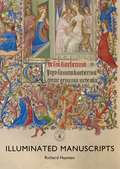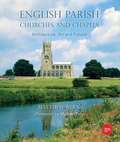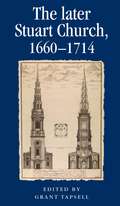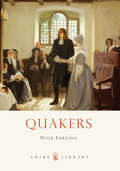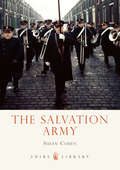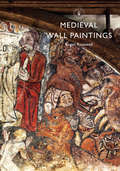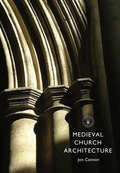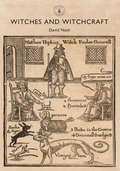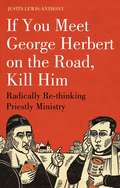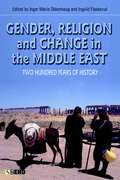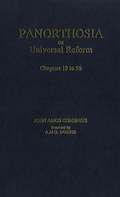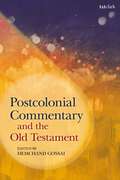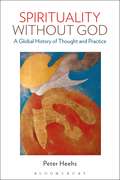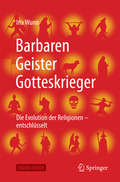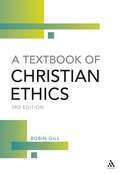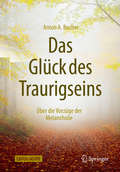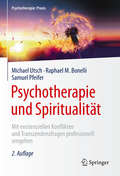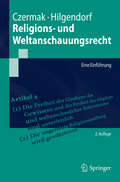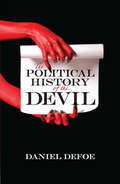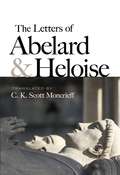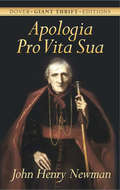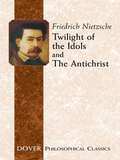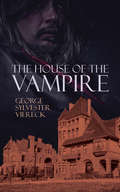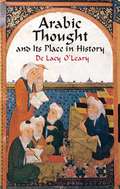- Table View
- List View
Illuminated Manuscripts (Shire Library)
by Richard HaymanIlluminated manuscripts are among the most beautiful, precious and mysterious works of Western art. Before the printing press was invented, books were produced by hand and their illustration using brightly coloured pigments and gold embellishments was a labour of love and an act of piety in itself. The results are stunning. The works emanating from the scriptoria of monasteries were mainly religious texts, including illuminated bibles, psalters, and works for private devotion known as books of hours. Illuminated Manuscripts describes the origin and history of illumination in the Middle Ages, covering the artists and their techniques, and the patrons who commissioned them. It explains the subject matter found in medieval works, such as saints and Bible stories and the use of ornamental flourishes, and is illustrated with many fine examples of the genre including the Lindisfarne Gospels and the Book of Kells.
English Parish Churches and Chapels: Art, Architecture and People
by Matthew ByrneThere are over 40,000 churches and chapels in the United Kingdom. The earliest were built by the first Anglo-Saxon Christians and about 10,000 were built before the Reformation in the sixteenth century. This beautifully illustrated book features photographic portraits and descriptions of 26 English churches and chapels: ancient and modern, large and small, urban and rural. It reveals the beauty of this group of buildings, the history and significance of which are unmatched anywhere in the world. This book is published in association with The National Churches Trust, a national, independent charity dedicated to supporting church buildings across the UK.
The later Stuart Church, 1660–1714 (Politics, Culture and Society in Early Modern Britain #Politics, Culture and Society in Early Modern Britain)
by Grant TapsellThis book features nine essays written by leading scholars in the field to offer new insights into the place of the Church of England within the volatile Restoration era. Sections on ideas and people include essays covering the royal supremacy, the theology of the later Stuart Church and clerical and lay interests.
Quakers (Shire Library)
by Peter FurtadoThough there have never been many Quakers, these small numbers belie the sect's tremendous impact, both historical and contemporary. Quakerism has produced an astonishing and disproportionate number of eminent thinkers, scientists, industrialists and businessmen, who are united not only by their success but by their commitment to philanthropy and social justice. Quakers also played an important role in early American history, William Penn even having a state named after him. In this illustrated introduction, Peter Furtado traces the history of Quakerism through the tumultuous period of the Civil War and Restoration, its zealous and unrelenting opposition to the slave trade, and its continued work at the forefront of peacemaking, poverty relief, conflict resolution and charity. He also looks closely at the egalitarian teachings of Quakerism's founder, George Fox, and at how the sect's beliefs have developed since, including their undaunted pacifism and why they have been so successful in business.
The Salvation Army (Shire Library #748)
by Susan CohenThe Salvation Army is a byword for philanthropy and charitable work, with its brass bands and uniformed officers indelible parts of the fabric of British life – yet many may not be aware of the real extent of its work and influence. This is the story of how Reverend William Booth's East London Christian Mission of 1865 (which became the Salvation Army in 1878) has become a truly global enterprise, one that in Britain is still second only to the government in the provision of social care. It is a symbol of charity that was forged in the crucible of mid-Victorian Britain and is now known in more than 120 countries, and Susan Cohen here explains and illustrates its activities and structures, its history and present, and its very important legacy.
Medieval Wall Paintings (Shire Library)
by Roger RosewellThe medieval wall paintings that remain in English churches are for the most part shadows of their former selves – the rare fragments of this beautiful art to have survived not only the Reformation but also successive waves of iconoclastic zeal and unsympathetic restoration. The whitewashed walls of most parish churches belie the riot of colour and decoration that once adorned them, but the remnants of paintings tucked into corners or rescued from later layers of paint help us to understand the role of art in medieval religion. Roger Rosewell here offers a guide to the role played by medieval wall paintings, as religious, didactic and commemorative works of art, telling the stories of those who created them and those who used them on a daily basis. He also compares and contrasts religious and domestic wall paintings, using beautiful colour photography throughout.
Medieval Church Architecture (Shire Library)
by Jon CannonBritain is a treasure trove of medieval architecture. Almost every village and town in the land has a church that was built during the period, whose history is legible – to those who know how to look – in every arch, capital, roof vault, and detail of window tracery. By learning how to identify the stylistic phases that resulted from shifts in architectural fashion, it is possible to date each part of a church to within a decade or two; this book introduces all the key features of each succeeding style, from Anglo-Saxon and Norman through to the three great gothic styles, Early English, Decorated and Perpendicular. It will be indispensable to anyone who enjoys exploring medieval churches, and who wants to understand and appreciate their beauty more deeply.
Witches and Witchcraft (Shire Library #765)
by David NashWitchcraft haunts the Western imagination to this day, from Central Europe to Britain to North America. This book explores the development of witchcraft and of the belief in it (stressing the difference between the two), the sixteenthand seventeenth-century obsession that spawned witch-hunting, the eventual decline of witchcraft, and the phenomenon's fascinating 'afterlife' that has involved the Nazis' fixation and modern treatments including Arthur Miller's acclaimed The Crucible. Fully illustrated with historical documents and colour photographs, and expertly written by Professor David Nash, this book is the perfect introduction to a subject that is compelling, disturbing and a little-understood cultural touchstone.
If you meet George Herbert on the road, kill him: Radically Re-thinking Priestly Ministry
by The Revd Justin Lewis-AnthonyPriestly ministry in the Church of England needs a radical rethink...George Herbert died in 1633. His legacy continues. His poems are read and sung, and his parish ministry remains the model for the Church of England's understanding of how and where and why its priests should minister. But there is a problem. The memory of Herbert celebrated by the Church is an inaccurate one, and, in its inaccuracy, is unfair on Herbert himself and his successors in the ordained ministry. This is a book of the long view. It sets out to assess realistically the context of Herbert's life and to explore the difficulties of parish life today. By examining the status and role of parish clergy since Herbert's time and today, it draws on the work of historians, social anthropologists, psychologists and theologians, and presents their ideas in a readable and passionate style. It argues that the future strength of parochial ministry will be found in a recovery of historic, renewed understandings of priestly ministry, and concludes by outlining more sustainable patterns of practice for the future.In a climate of uncertainty for the future of the church, it will be an encouragement for priest and people, and welcomed by both.
Gender, Religion and Change in the Middle East: Two Hundred Years of History
by Inger Marie Okkenhaug Ingvild FlaskerudThe complicated link between women and religion in the Middle East has been a source of debate for centuries, and has special resonance today. Whether religion reinforces female oppression or provides opportunities for women - or a combination of both - depends on time, place and circumstance. This book seeks to contextualize women's roles within their religious traditions rather than through the lens of a dominant culture. Gender, Religion and Change in the Middle East crosses boundaries and borders, and will appeal to a global audience. This book provides a comprehensive survey of women in Muslim, Jewish and Christian communities in the Middle East during the last two centuries. The authors consider women's defined roles within these religious communities, as well as exploring how women themselves develop and apply their own strategies within religious societies. The wide-ranging accounts draw on case studies from Iran, Turkey, Afghanistan, Israel, Jordan, Egypt, Palestine and Lebanon since 1800. Throughout, the authors challenge our understanding of patriarchy to offer a more nuanced account. Taking a balanced look at the issues of religion, gender and change in the Middle East, this unique interdisciplinary study gives new insight to the theme of women and religion in the Middle East.
Panorthosia by Comenius 19-26
by A.M.O. DobbiePanorthosia (Universal Reform) is the essential theme of John Amos Comenius's famous Consultation on the Reform of Human Affairs, and chapters 19-26 represent its climax. In this volume is presented the first English translation of this major work of Comenius, which was lost from about 1672 until 1934 when the Latin scholars of Czechoslovakia had it edited for publication in Prague in 1960.
Postcolonial Commentary and the Old Testament
by Hemchand GossaiThis is the first volume to provide a wide range of postcolonial interpretations of and commentaries upon significant texts in the Hebrew Bible. The volume intersects with the work of the key theorists in postcolonial studies such as Fanon, Senghor, Said and Spivak as well as with scholars such as Sugirtharajah, Kwok Pui-lan, and Segovia who have applied this theory to biblical studies. Texts have been chosen specifically for their relevance to postcolonial discourse, rather than seeking to cover each biblical document. This volume is designed to demonstrate how historical criticism, postmodernism, and the important concerns of postcolonial readings may be integrated to obtain an informed explanation of the Hebrew Bible and the writings of early Judaism. The chapters are written by scholars who represent a spectrum of national, indigenous, and diasporic contexts. Taken together these perspectives and the interpretations they yield represent a continued expansion of the manner in which Old Testament texts are read and interpreted through postcolonial lenses, reminding readers that the interpretive trajectories of these texts are almost inexhaustible. As such the volume serves as not only an addition to ongoing scholarship on postcolonialism but also as an expansion of the horizon for dialogue.
Spirituality without God: A Global History of Thought and Practice
by Peter HeehsSpirituality without God is the first global survey of “godless” spirituality. Long before “spiritual but not religious” became the catchphrase of the day, there were religious and spiritual traditions in India, China, and the West that denied the existence of God. Peter Heehs begins by looking at godless traditions in the ancient world. Indian religions such as Jainism and Buddhism showed the way to liberation through individual effort. In China, Confucians and Daoists taught how to live in harmony with nature and society. Philosophies of the Greco-Roman world, such as Epicureanism, Stoicism, and Skepticism, focused on enhancing the quality of life rather than buying the favor of the gods through sacrifice or worship. Heehs shows how these traditions, rediscovered during the Renaissance, helped jump-start the European Enlightenment and opened the way to the atheism and agnosticism of the eighteenth and nineteenth centuries. The personal, inner, approach to religion became known as "spirituality.” Spirituality without God is a counterbalance to theistic narratives that have dominated the field, as well as an introduction to modes of spiritual thought and practice that may appeal to people who have no interest in God.
Barbaren, Geister, Gotteskrieger: Die Evolution der Religionen – entschlüsselt
by Ina WunnEin neuer Blick auf die Entwicklung der Religionen In diesem Buch geht es um die Evolution der Religionen, also um die Frage, wie und warum sich Religionen im Laufe ihrer geschichtlichen Entwicklung verändern und welche Gesetzmäßigkeiten diesen Veränderungen zugrunde liegen. Die Autorin schildert zunächst, wie der Evolutionsgedanke sowohl in der Biologie als auch in den Geisteswissenschaften Fuß gefasst hat. Dies war eine Zeit eigenwilliger Protagonisten und spannender Kontroversen, die lebhaft vor das Auge des Lesers treten. Das Buch geht dann der Frage nach, was Evolution im Bereich der Religion eigentlich bedeutet und welche Faktoren diese religiöse Evolution steuern. Welcher Anpassungswert kommt Religionen zu? Wie spalten sich Religionen auf und entwickeln sich in zunehmender Eigenständigkeit? Gibt es so etwas wie eine Vererbung, eine Stammesgeschichte und eine Systematik der Religionen, ähnlich des Gedankengebäudes, das die biologische Evolutionstheorie für die Entwicklung der Organismenwelt entworfen hat? Am Ende dieses mutigen Buches steht nicht nur eine belastbare Theorie religiöser Evolution, sondern es wird auch deutlich, welche Umwelt- und sozialen Faktoren die Entwicklung von Religionen heute steuern. In einer Welt, in der das Religiöse mit Macht zurückzukehren scheint, dürfte dieses Werk auch zu einem differenzierteren Blick auf die Vielfalt und Einheit der Religionen beitragen. Die Autorin Ina Wunn ist Professorin für Religionswissenschaft an der Leibniz-Universität Hannover. Das besondere Interesse der Biologin und Religionswissenschaftlerin gilt dem Ursprung und der Evolution der Religionen.
A Textbook of Christian Ethics, 3rd Edition
by Robin GillRobin Gill's Textbook of Christian Ethics has been a popular course book with students and lecturers for over 20 years. Now in its third edition this classic textbook has been completely revised to bring it up to date with recent developments in the field of Christian Ethics. All the popular features of the previous editions have been retained in this new edition. The book's main strength has always been its layout and structure. Integrating primary texts with explanatory material from the author, the book provides the student with a reader and textbook combined. The new edition focuses more strongly on current debates in all sections and expands on a variety of topics, with contributions on natural law approaches, virtue ethics in a pluralistic/postmodern world, the influential notion of the 'common good', just war theory, genetics and biotechnology, euthanasia and global justice, and sex and gender issues. Important modern contributions to Christian ethics are set out alongside classical texts from Augustine, Aquinas and Luther. The modern writers range from thinkers such as Niebuhr, Barth and Bonhoeffer to recent liberation and Third World theologians. Each series of texts is systematically analysed. The differing ethical positions and arguments are examined together with the social and historical factors which shaped them.
A Friend for Christmas
by Gloria StewartYorkshire, Christmas, 1953. They'd had a cold and hungry winter but Gloria's mother had scrimped and saved to ensure the fire was lit and her five children each had a plate full of food. There was even a place at the table ready for an unexpected visitor; every year there seemed to be someone in need.Despite the busy household, Gloria often ended up playing by herself. That is, until a knock on the door that brought a scruffy pup into her life and her heart. Over the years, Gloria adopted many more dogs, even the odd cat, who helped her through the good times and the bad; through illness, love and loss. They even helped her to carry on her mother's legacy, bringing warmth, food and happiness to those alone at Christmas.
Das Glück des Traurigseins: Über die Vorzüge der Melancholie
by Anton A. BucherIn diesem Buch über Glück und Melancholie können alle, die von dem Trend-Phänomen Glücksstreben ermüdet sind, erfahren, was zu einem wirklich guten Leben gehören könnte. In einer Zeit, zu der man den Eindruck bekommt, jeder Zweite sei von Burnout betroffen und jeder Vierte von einer Depression, lädt der Autor ein, die Vorzüge der Melancholie zu entdecken: Traurigkeit als Kompetenz, Widersprüche zu empfinden, und als komplexes, schöpferisches Gefühl, das ein Leben in emotionaler Vielfalt ermöglichen kann. Lernt man die Melancholie wertzuschätzen, kann sie einen ganz eigenen Weg ins Glück aufzeigen.Aus dem Inhalt: Streifzüge durch die Glücksgesellschaft – Glück als Pflicht? – Wenn sich positives Denken negativ auswirkt – Das Glück des Traurigseins – Empirische Daten zu Melancholie – Vorzüge der Melancholie.Über den Autor: Prof. Dr. Anton A. Bucher widmet sich neben seinen universitären Studien gern psychologischen Aspekten des guten Lebens und ist Autor mehrerer erfolgreicher Bücher.
Psychotherapie und Spiritualität: Mit existenziellen Konflikten und Transzendenzfragen professionell umgehen (Psychotherapie: Praxis)
by Michael Utsch Raphael M. Bonelli Samuel PfeiferDieses Buch setzt sich fundiert damit auseinander, wie die Ressource Spiritualität – die Praktiker ebenso wie Patienten zunehmend beschäftigt – professionell anzuwenden ist und wo die Grenzen sind. Existenzielle Konflikte und damit verbundene Fragen der Spiritualität und Religion sind heute in Psychotherapie und Psychiatrie kein Tabu mehr. Eine kultursensible Behandlung erfordert Wissen und Einfühlungsvermögen für die Glaubenswelt des Klienten. Darüber hinaus vermittelt das Buch Grundlagen zum Verständnis und zur therapeutischen Begleitung religiöser Menschen in psychischen Krisen. Die 2., vollständig überarbeitete Auflage ist erweitert um Kapitel zu Narzissmus und Achtsamkeit. Geschrieben für Psychotherapeuten in Klinik und Praxis, Psychiater, Mitarbeiter in Beratungsstellen, Seelsorger, interessierte Klienten.Aus dem Inhalt: I Umgang mit Sinnfragen und Transzendenz in der Psychotherapie – II Spiritualität aus psychotherapeutischer Sicht – III Spiritualität in der psychotherapeutischen Praxis – IV Berührungspunkte zwischen Psychotherapie und Spiritualität.Die Autoren: Michael Utsch, Prof. Dr. phil., wissenschaftlicher Referent der Evangelischen Zentralstelle für Weltanschauungsfragen in Berlin, Honorarprofessor für Religionspsychologie an der Evangelischen Hochschule „Tabor“ in Marburg. Raphael M. Bonelli, Univ.-Doz. Dr. med. Dr. scient., Psychiater und systemischer Psychotherapeut in eigener Praxis. Samuel Pfeifer, Prof. Dr. med., Facharzt für Psychiatrie und Psychotherapie.
Religions- und Weltanschauungsrecht: Eine Einführung (Springer-Lehrbuch)
by Gerhard Czermak Eric HilgendorfDas Religions(verfassungs)recht hat angesichts der veränderten religionspolitischen Lage Konjunktur. Das Buch gibt eine kompakte Einführung in die theoretisch und praktisch wichtigsten Bereiche des Religionsrechts und greift vernachlässigte Fragen (etwa im Schulwesen oder bei der Kirchensteuer) auf. Es will überzeugen durch klare rechtliche Grundbegriffe und eine Abkehr von einer einseitig kirchenzentrierten Sichtweise. Normtexte und Rechtsprechungsübersichten runden das leserfreundliche, auch für Nichtjuristen interessante Buch ab.
The Political History of the Devil: As Well Ancient As Modern; In Two Parts (classic Reprint) (Ams Studies In The Eighteenth Century Ser. #No. 44)
by Daniel DefoeIrreverent and ironic, this 1726 satire by the author of Robinson Crusoe examines the evolution of evil and the rise of the historical force known as "the devil." Daniel Defoe's passionate and perceptive survey starts with Satan's origins, chronicling the devil's presence in the Bible and his growing sway over humanity. An overview of satanic influences on eighteenth-century life follows, focusing on monarchs and tyrants as well as common folk. Defoe supports his arguments not only with extensive quotes from scripture but also with citations from other sources, including Milton's Paradise Lost.Written at the dawn of the Enlightenment, this treatise recaptures a moment in time when widespread certainty of the devil's existence was dwindling. Defoe, a firm believer, posits that the devil reacted to the changing times by shifting his influence from the supernatural realm of witches and wizards to the ordinary world of "beaus, beauties, wits, and fools." This intriguing view of politics and society during the 1700s offers a vivid contemporary portrait of a culture torn between theology and reason.
The Letters of Abelard and Heloise
by C. K. MoncrieffAbelard, a prominent twelfth-century theologian, is hired to tutor Heloise, a brilliant pupil who becomes his lover and the mother of his child. Although the two are secretly married, a misunderstanding leads to Abelard's castration by Heloise's uncle, followed by the lovers' permanent separation. Abelard retreats to a monastery and Heloise to a nunnery — and their subsequent correspondence captured the romantic imaginations of generations of readers. The letters offer insights into the thinking of Abelard, who ranks among the Middle Ages' foremost philosophers, and the spirited determination of Heloise, an early feminist. They have also excited ongoing controversy in terms of their historical content and significance. Translator C. K. Scott Moncrieff takes a modern approach to the correspondence, adding new significance to its reflection of medieval attitudes toward love, marriage, and religion.
Apologia Pro Vita Sua
by John Henry NewmanA highly influential figure in the Church of England, John Henry Newman stunned the Anglican community in 1843, when he left his position as vicar of St. Mary's, Oxford, to join the Roman Catholic church. Perhaps no one took greater offense than Protestant clergyman Charles Kingsley, whose scathing attacks against Newman's faith and honor inspired this brilliant response. Apologia Pro Vita Sua, Newman's spiritual autobiography, explores the depths and nature of Christianity with flowing prose and a conversational style that has ensured its status as a classic."False ideas may be refuted by argument, but by true ideas alone are they expelled. I will vanquish," Newman promised, "not my accuser, but my judges." His honest and passionate defense consists of a personal history of his religious convictions, from earliest memory through the Oxford movement and his ultimate conversion. His concluding point-by-point refutation of Kingsley's charges features thought-provoking contentions that strike at the very roots of the principles underlying Protestantism. Newman won respect and admiration with his Apologia, a work that has helped clarify perceptions of Roman Catholicism among readers of every faith.
Twilight of the Idols and The Antichrist
by Friedrich Nietzsche Thomas Common"Books for everybody are always malodorous books: the smell of petty people clings to them," scoffed Friedrich Nietzsche. These two works, Twilight of the Idols and The Antichrist, crowned the radical philosopher's career of writing books that are decidedly not for everyone. Written in 1888, while Nietzsche was at the height of his brilliance — but shortly before the onset of the insanity that gripped him until his death in 1900 — they blaze with provocative, inflammatory rhetoric.Nietzsche's "grand declaration of war," Twilight of the Idols examines what we worship and why. Intended by the author as a general introduction to his philosophy, it assails "idols" of Western philosophy and culture (Socratic rationality and Christian morality among them) and sets the scene for The Antichrist. In addition to its full-scale attack on Christianity and Jesus Christ, The Antichrist denounces organized religion as a whole. H. L. Mencken declared that "it is, to many sensitive men, in the worst possible taste, but at bottom it is enormously apt and effective — on the surface, it is undoubtedly a good show." Students of philosophy, history, and German literature will find these works essential to an understanding of Nietzschean philosophy.
The House of the Vampire
by George Sylvester Viereck"He felt the presence of the hand of Reginald Clark - unmistakably - groping in his brain as if searching for something that had still escaped him. He tried to move, to cry out, but his limbs were paralyzed. When, by a superhuman effort, he at last succeeded in shaking off the numbness that held him enchained, he awoke just in time to see a figure, that of a man, disappearing in the wall that separated Reginald's apartments from his room..."This vampire doesn't want the blood from your veins; he's after the ideas in your head. The hypnotic Reginald Clarke chooses his victims for their artistic abilities, charms them, and discards them after robbing them of their gifts. Originally published in 1907, this gothic novella was among the first stories of its type and remains a gripping tale of psychic vampirism.
Arabic Thought and Its Place in History
by De Lacy O'LearyWell-documented study of the mutual influence of Arabic and Western worlds during the Middle Ages traces the transmission of Greek philosophy and science to the Islamic cultures. A fascinating portrait of medieval Muslim thought, it illustrates commonalities with Judaic and Christian teachings as well as points of divergence.
